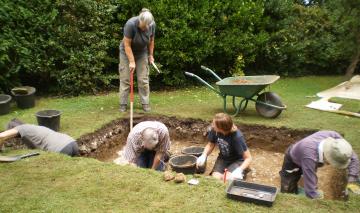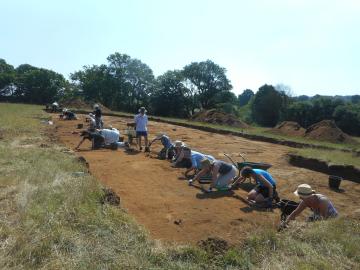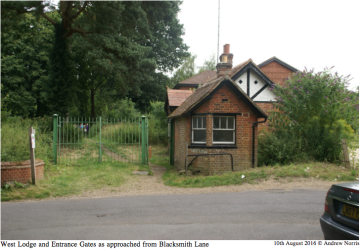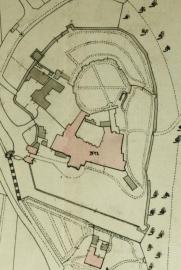Research & Fieldwork Reports - by date of work
The articles below record research and fieldwork undertaken by the Society. Many have not been published elsewhere. Click on the item header or the 'Read more' link to read the complete article. The articles are arranged in descending order of the work done, NOT the date of publication.
Bookham Courte 2017
A fourth season of excavation at Bookham Courte, a medieval manor house near the centre of Great Bookham. Of the four new trenches, one was an extension of trench 7 in 2016. All the trenches contained medieval pottery suggesting the site went back to the 11th century. The remains of flint and mortar walls were found, but the archaeology showed that there had been various buildings or structures in the area over a long period.
Excavations at Cocks Farm Abinger 2017
The annual excavation took place at Cocks Farm Abinger in June-July 2017 under the direction of Emma Corke. Volunteers excavated two trenches in an area of high agricultural activity on the hill adjacent to the known Roman villa site. This area was identified during a magnetometry survey looking at the environs of the villa which uncovered a Roman field system, a Roman lime kiln and a concentration of pits.
Watching brief at 88B West Street, Farnham 2017
Watching brief by D&A Graham of SyAS. The footing trenches for an extension were examined. No finds or features of archaeological interest were revealed, with the site having apparently been horizontally truncated during the construction of a previous extension in the 20th century.
For more information please view the attached report
Excavation at Cocks Farm, Abinger 2016
An 8th season of excavation in the current project took place in the field adjacent to the known Roman villa. Two trenches were sited to both pick up and clarify features found in 2015 and to explore magnetic anomalies to the NE of the 2015 trench. The smaller of the trenches to the west of the main trench uncovered just the base of the IA enclosure ditch and the lower 60cm of a storage pit, confirming the loss of archaeological features to erosion on the western slope of the field.
Geophysical survey and trial trenching at New Barn Field, Green Lane, Wanborough, 2016
The well-known Roman temples site at Wanborough lies north of the Hog’s Back between Farnham and Guildford. The site was first excavated in 1979, again in 1985/6 following large scale treasure hunting and most recently in 1999 when David Williams directed an excavation that revealed a second earlier circular temple (Surrey Archaeological Collections vols 75, 82 and 93 respectively).
West Lodge Chilworth Gunpowder Works - assessment of building sequence 2016
The West Lodge building(s) is to the east side of Blacksmith Lane at the west (main) entrance to the Chilworth Gunpowder Mills Middle Works site originally serving as an entry control point.
Ashtead Roman Villa Project 2006-2013
Ashtead Roman villa was first discovered in the 1920s and excavated by A. W. G. Lowther and A. R. Cotton, when extensive evidence for a tilery was also noted. Further work was carried out in the 1960s by John Hampton who carried out a site survey; the site had much less vegetation cover than is now the case. Both Lowther’s published reports and Hampton's survey left many unanswered questions aand so a new research programme was initiated in 2006, directed by Dr. David Bird.
Excavations at Cocks Farm Abinger 2015
A month of excavation took place in June 2015 in the field outside the scheduled villa area. Thanks to all the volunteers who worked tirelessly on the sandy subsoil to uncover evidence for probably two consecutive later Iron Age enclosures on the hilltop, each with large, deep flat-bottomed storage pits surely intended for grain. A number of late Iron Age and Roman ditches were also uncovered and these and the pits validated the findings of the magnetometry surveys undertaken in the field over the last few years.
Farnham Castle, new footpath 2015
Resistivity survey and trial trenching by D Graham of SyAS in advance of the construction of a new footpath from the postern gate to the buildings of the bailey. Both trenches contained disturbed ground with 19th century and later material.





